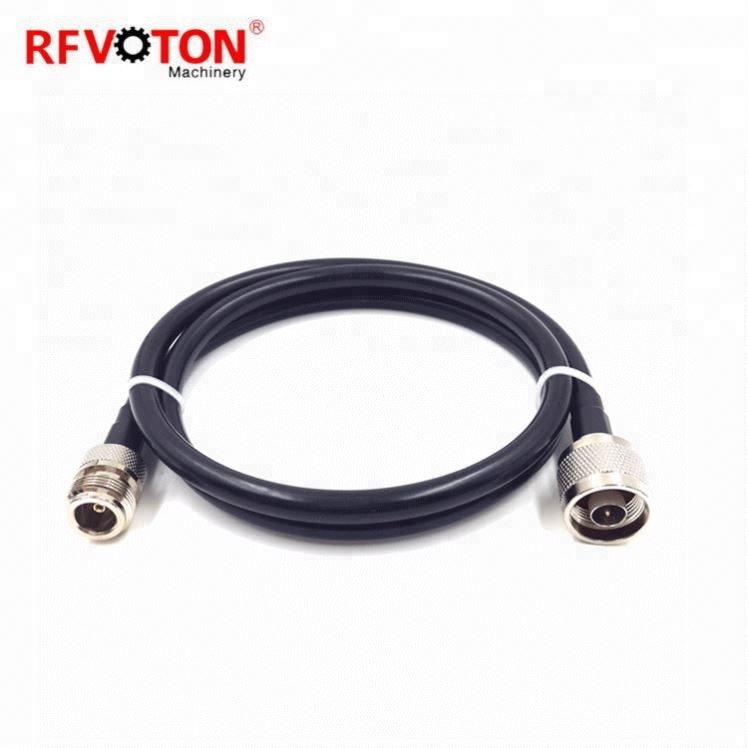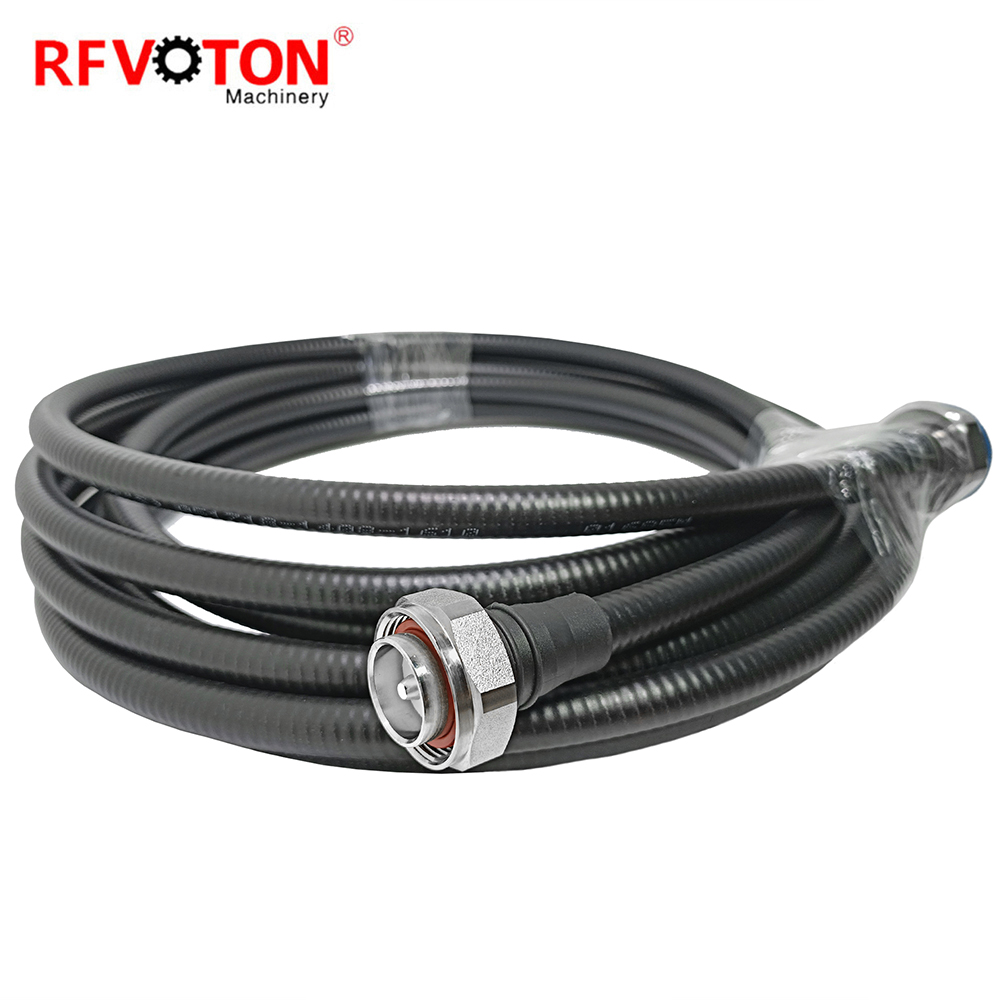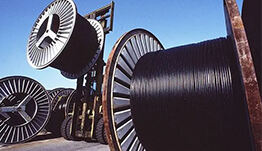Analyse de la vitesse de propagation du signal dans les câbles coaxiaux
La vitesse de propagation des signaux RF dans les câbles coaxiaux est généralement comprise entre 70 % et 90 % de la vitesse de la lumière, selon la constante diélectrique du câble coaxial et ses dimensions géométriques. Cet article analysera brièvement la vitesse de propagation des modèles RF.

connecteur femelle N vers mâle N pour lMR400 assemblage de câbles
1,La vitesse de propagation des signaux RF dans les câbles coaxiaux
Le câble coaxial est un câble couramment utilisé pour la transmission de signaux RF, composé d'un conducteur central, d'une couche isolante, d'un conducteur externe et d'une couche protectrice externe. Le conducteur central et le conducteur externe assurent respectivement les pôles positif et négatif du signal, la couche isolante servant à isoler le champ électrique, et la couche protectrice externe à protéger contre les interférences extérieures. Dans les câbles coaxiaux, les signaux radiofréquence sont transmis par des champs électromagnétiques entre les conducteurs et les couches isolantes.
La vitesse de propagation des signaux RF dans les câbles coaxiaux dépend de la constante diélectrique du câble coaxial et des dimensions géométriques du câble. En général, la vitesse de propagation des signaux RF dans les câbles coaxiaux est d'environ 70 % à 90 % de la vitesse de la lumière.
Plus la constante diélectrique est grande et plus la taille géométrique du câble est petite, plus la vitesse de propagation du signal RF est élevée. Cela s'explique par le fait qu'une constante diélectrique plus élevée accroît la vitesse de propagation du champ électromagnétique dans la couche d'isolation ; quant à la taille géométrique plus réduite du câble, elle diminue la distance et donc le temps de propagation du signal.

Connecteur N femelle chassis vers SMA mâle pour Assemblage de câble RG405 086
2,Comment calculer le temps de propagation et la distance de transmission des signaux RF dans les câbles coaxiaux
Dans les systèmes de communication, il est nécessaire de calculer le temps de transmission en fonction de la vitesse et de la distance de propagation du signal afin d'optimiser la conception et les performances du système. Dans les câbles coaxiaux, on peut utiliser la formule suivante pour calculer le temps de transmission et la distance des signaux RF :
Temps de transmission = distance de transmission / vitesse de propagation
Distance de transmission = vitesse de propagation × temps de transmission
Parmi eux, les unités de vitesse de propagation, de temps de transmission et de distance de transmission sont respectivement m/s, s et m. Par exemple, lorsque la constante diélectrique d'un câble coaxial est de 2,3, sa vitesse de propagation est d'environ 2,07 × 10^8 m/s. Si le signal doit être transmis de l'extrémité émettrice à l'extrémité réceptrice, et que la distance de transmission est de 500 mètres, le temps de transmission est d'environ 2,41 microsecondes (temps de transmission = 500 / 2,07 × 10^8), et si la distance de transmission est de 1000 mètres, le temps de transmission est d'environ 4,82 microsecondes.

7/16 Din mâle vers 7/16 Din mâle avec câble raccord souple 1/2"
3, Comment améliorer la vitesse de transmission des câbles coaxiaux
Dans les applications pratiques, afin d'améliorer la vitesse de transmission des câbles coaxiaux, les mesures suivantes peuvent être prises :
1. Choisir le câble coaxial approprié : sélectionner des câbles coaxiaux ayant une constante diélectrique plus élevée et des dimensions géométriques plus petites en fonction des besoins réels de communication.
2. Optimiser la méthode de connexion des câbles : l'utilisation de connecteurs de haute qualité et de méthodes de connexion appropriées peut efficacement réduire les pertes de transmission du signal et améliorer la vitesse de transmission.
3. Optimiser l'environnement des câbles : lors de l'installation et de l'utilisation de câbles coaxiaux, il convient de s'efforcer d'éviter les effets néfastes de l'environnement, tels que les vibrations mécaniques et les interférences électromagnétiques, sur les câbles afin de garantir une transmission stable et normale du signal.
Actualités à la Une
-
Qu'est-ce qu'un connecteur coaxial RF ? Quelles sont ses caractéristiques et applications ?
2025-07-01
-
Connecteur BNC
2024-07-22
-
Connecteur sma
2024-07-19
-
La différence entre les connecteurs BNC et SMA
2024-07-03
-
Quels sont les avantages des câbles coaxiaux anti-perturbations
2023-12-18
-
Guide complet des connaissances de base sur les connecteurs coaxiaux
2023-12-18
-
Pourquoi la capacité anti-perturbation des câbles coaxiaux est-elle si forte
2023-12-18

 EN
EN
 AR
AR
 BG
BG
 HR
HR
 CS
CS
 NL
NL
 FI
FI
 FR
FR
 DE
DE
 EL
EL
 HI
HI
 IT
IT
 JA
JA
 KO
KO
 NO
NO
 PL
PL
 PT
PT
 RO
RO
 RU
RU
 ES
ES
 TL
TL
 IW
IW
 ID
ID
 VI
VI
 HU
HU
 TH
TH
 TR
TR
 FA
FA
 MS
MS
 UR
UR
 HA
HA
 JW
JW
 LA
LA
 MY
MY
 KK
KK
 TG
TG
 UZ
UZ
 AM
AM
 PS
PS

